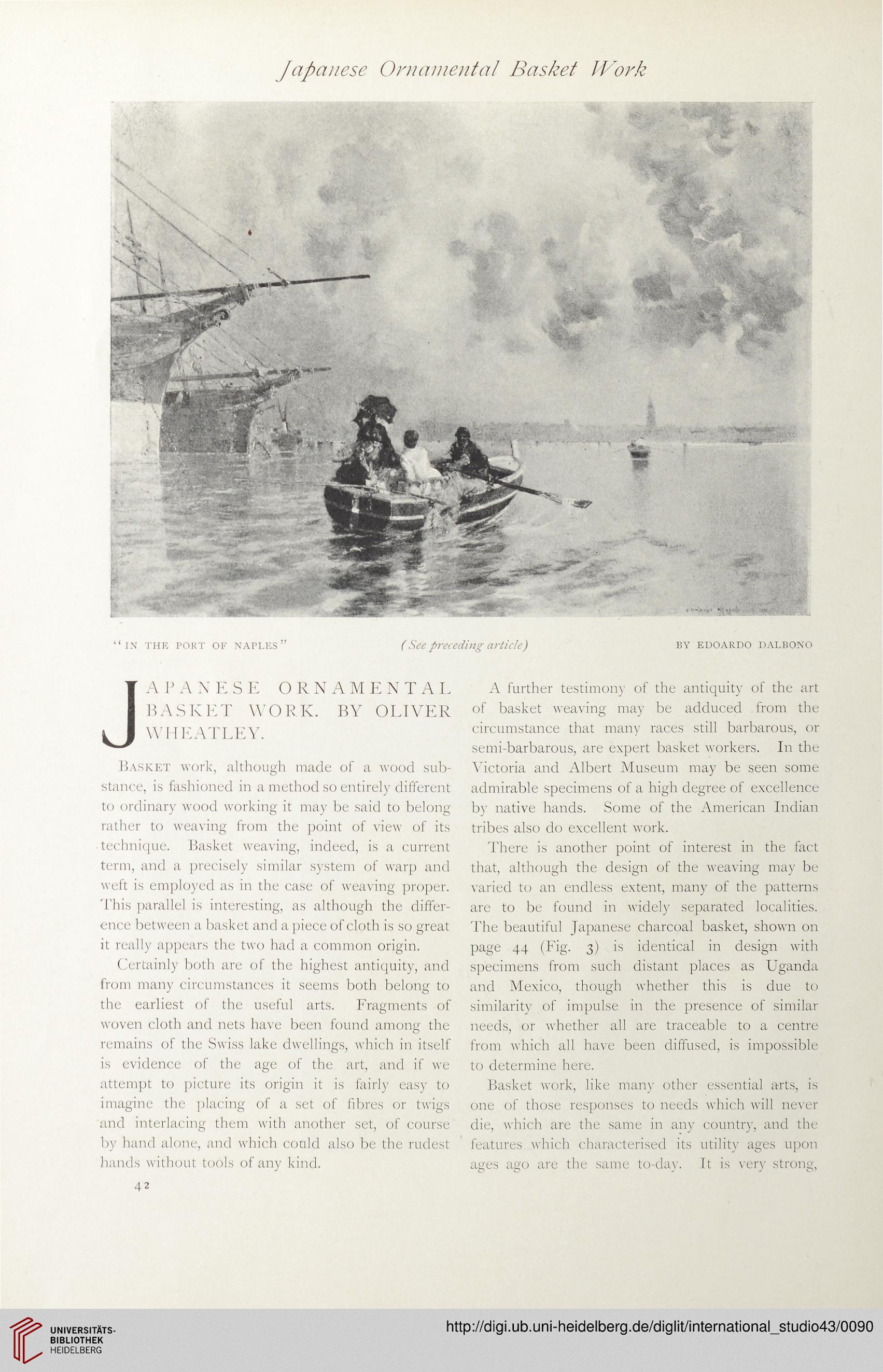/apanese Ornamental Basket Work
“in the port of Naples”
(See preceding article)
BY EDOARDO DALBONO
JAPANESE ORNAMENTAE
BASKET WORK. BY OLIVER
WHEATLEY.
Basket work, although made of a wood sub-
stance, is fashioned in a method so entirely different
to ordinary wood working it may be said to belong
rather to weaving from the point of view of its
technique. Basket weaving, indeed, is a current
term, and a precisely similar system of warp and
weft is employed as in the case of weaving proper.
This parallel is interesting, as although the differ-
ence between a basket and a piece of cloth is so great
it really appears the two had a common origin.
Certainly both are of the highest antiquity, and
from many circumstances it seems both belong to
the earliest of the useful arts. Fragments of
woven cloth and nets have been found among the
remains of the Swiss lake dwellings, which in itself
is evidence of the age of the art, and if we
attempt to picture its origin it is fairly easy to
imagine the placing of a set of fibres or twigs
and interlacing them with another set, of course
by hand alone, and which could also be the rudest
hands without tools of any kind.
A further testimony of the antiquity of the art
of basket weaving may be adduced from the
circumstance that many races still barbarous, or
semi-barbarous, are expert basket workers. In the
Victoria and Albert Museum may be seen some
admirable specimens of a high degree of excellence
by native hands. Some of the American Indian
tribes also do excellent work.
There is another point of interest in the fact
that, although the design of the weaving may be
varied to an endless extent, many of the patterns
are to be found in widely separated localities.
The beautiful Japanese charcoal basket, shown on
page 44 (Fig. 3) is identical in design with
specimens from such distant places as Uganda
and Mexico, though whether this is due to
similarity of impulse in the presence of similar
needs, or whether all are traceable to a centre
from which all have been diffused, is impossible
to determine here.
Basket work, like many other essential arts, is
one of those responses to needs which will never
die, which are the same in any country, and the
features which characterised its utility ages upon
ages ago are the same to-day. It is very strong,
42
“in the port of Naples”
(See preceding article)
BY EDOARDO DALBONO
JAPANESE ORNAMENTAE
BASKET WORK. BY OLIVER
WHEATLEY.
Basket work, although made of a wood sub-
stance, is fashioned in a method so entirely different
to ordinary wood working it may be said to belong
rather to weaving from the point of view of its
technique. Basket weaving, indeed, is a current
term, and a precisely similar system of warp and
weft is employed as in the case of weaving proper.
This parallel is interesting, as although the differ-
ence between a basket and a piece of cloth is so great
it really appears the two had a common origin.
Certainly both are of the highest antiquity, and
from many circumstances it seems both belong to
the earliest of the useful arts. Fragments of
woven cloth and nets have been found among the
remains of the Swiss lake dwellings, which in itself
is evidence of the age of the art, and if we
attempt to picture its origin it is fairly easy to
imagine the placing of a set of fibres or twigs
and interlacing them with another set, of course
by hand alone, and which could also be the rudest
hands without tools of any kind.
A further testimony of the antiquity of the art
of basket weaving may be adduced from the
circumstance that many races still barbarous, or
semi-barbarous, are expert basket workers. In the
Victoria and Albert Museum may be seen some
admirable specimens of a high degree of excellence
by native hands. Some of the American Indian
tribes also do excellent work.
There is another point of interest in the fact
that, although the design of the weaving may be
varied to an endless extent, many of the patterns
are to be found in widely separated localities.
The beautiful Japanese charcoal basket, shown on
page 44 (Fig. 3) is identical in design with
specimens from such distant places as Uganda
and Mexico, though whether this is due to
similarity of impulse in the presence of similar
needs, or whether all are traceable to a centre
from which all have been diffused, is impossible
to determine here.
Basket work, like many other essential arts, is
one of those responses to needs which will never
die, which are the same in any country, and the
features which characterised its utility ages upon
ages ago are the same to-day. It is very strong,
42




